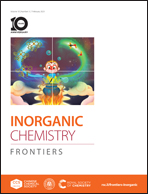Antiparallel alignment of the two angular momenta in a photoexcited dysprosium–phthalocyanine complex†
Abstract
The intramolecular magnetic interaction between a 4f electronic system in a dysprosium ion and a photoexcited macrocyclic π conjugate system in a 1 : 1 dysprosium–phthalocyaninato complex, [DyPc(cyclen)]Cl (Pc2− = phthalocyaninato dianion, cyclen = 1,4,7,10-tetraazacyclododecane), was investigated. Variable-temperature variable-field magnetic circular dichroism (VTVH-MCD) measurements of the Pc–Dy complex showed a reversal of the MCD pattern with decreasing temperature and a two-step dependence on the magnetic field. This observation indicates the presence of an interaction between the total angular momentum J of the 4f system and the orbital angular momentum L in the excited π system. A theoretical model considering the J–L interaction ΔJL was fitted to the temperature and magnetic-field dependence of the MCD A-term intensity, determining the interaction to be ΔJL = −2.7 cm−1. Ab initio RASSCF-RASSI calculations showed that the lowest Kramers doublet in the 4f ground multiplet was Jz = ± 11/2, while the J–L interaction in the excited states was estimated to be −2.0 and −1.5 cm−1 with two different levels of the basis set. The combination of the experiments and ab initio calculations clarified that the J–L interaction was essentially the interaction between the orbital angular momenta generated by the 4f and photoexcited π electronic system of the complex.



 Please wait while we load your content...
Please wait while we load your content...